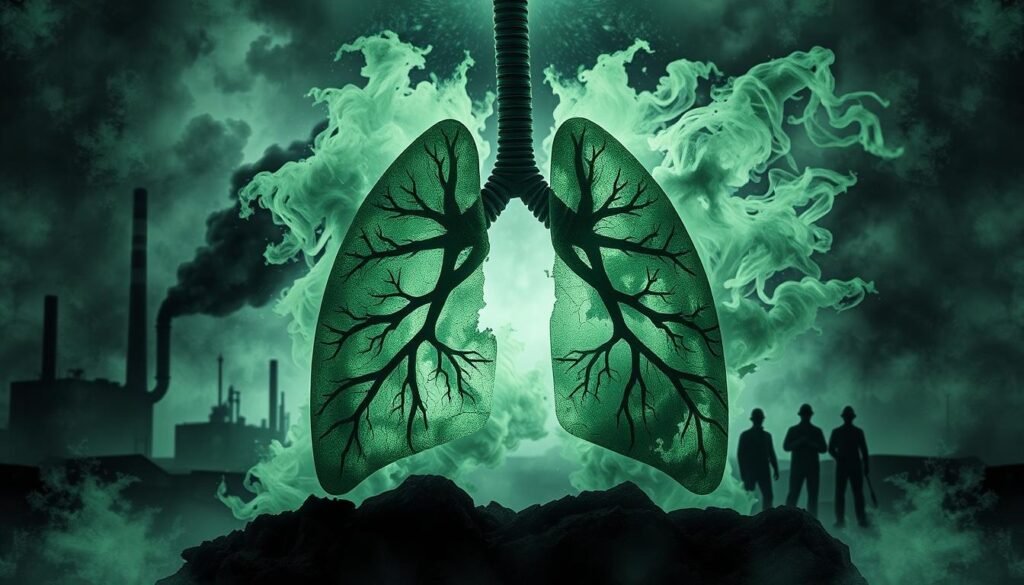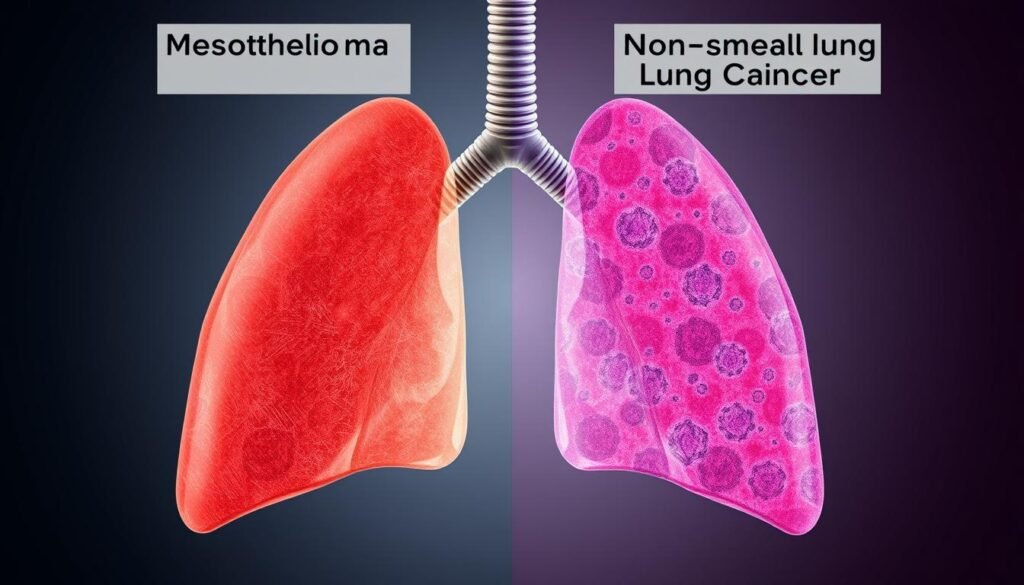Did you know lung cancer leads to more than 200,000 new cases every year in the United States? This makes it the most deadly form of cancer. About 80% to 85% of these are non-small cell lung cancer (NSCLC). Mesothelioma, which is rare but aggressive, is mostly caused by asbestos exposure. It has around 3,000 new cases yearly. Knowing the differences between mesothelioma and non-small cell lung cancer is vital for managing these conditions.
In this article, we’ll cover the important details about mesothelioma and non-small cell lung cancer. We’ll look at their symptoms, causes, how they’re diagnosed, treatment options, and what the future holds for patients. This knowledge makes it easier to understand their impact on public health and personal lives. It’s useful whether you’re just curious, looking for information, or need insights for professional reasons. This info on mesothelioma symptoms and lung cancer facts is crucial.
Key Takeaways
- Lung cancer accounts for over 200,000 cases annually in the U.S.
- NSCLC makes up 80% to 85% of all lung cancer cases.
- Mesothelioma is mainly triggered by asbestos exposure, while lung cancer is often linked to smoking.
- Shared symptoms between these cancers include chest pain and difficulty breathing.
- Effective diagnosis and treatment options are crucial for improving patient outcomes.
Understanding the Basics: Mesothelioma and Lung Cancer
Mesothelioma is a rare cancer that affects the lining around organs. It mostly happens near the lungs. Other types can be in the abdomen, heart, or testicles. Asbestos exposure is the main cause, especially in old buildings and some jobs.
Not everyone exposed to asbestos gets mesothelioma. Your risk is higher if you have a family history or worked with asbestos. Jobs in construction or shipyards are especially risky.
Lung cancer is mostly non-small cell lung cancer (NSCLC), which is 80% to 85% of cases. Smoking is the biggest risk for lung cancer. NSCLC has several types, like adenocarcinoma and squamous cell carcinoma. Each type grows differently.
Mesothelioma and lung cancer are caused by different things but share some risks. Knowing the differences helps in early detection and treatment.
What is Non-Small Cell Lung Cancer (NSCLC)?
Non-small cell lung cancer (NSCLC) is the most common lung cancer. It makes up about 80 to 85% of cases. Understanding its various subtypes and treatments is crucial. Smoking and environmental exposure are big risk factors.
Types of NSCLC
There are several types of NSCLC, each with their own features:
- Adenocarcinoma: This is the most common type, which starts in the mucus-producing cells of the airways.
- Squamous cell carcinoma: Found in the flat cells of the airway surfaces, usually near the middle of the lungs.
- Large cell carcinoma: Known for big cells and rapid growth.
- Adenosquamous carcinoma and Sarcomatoid carcinoma: These are rarer types.
Check out this resource for more on treatment impacted by NSCLC type.
Prevalence and Incidence Rates
Each year in the U.S., about 235,000 people are diagnosed with non-small cell lung cancer. This signifies a big health challenge. The increase in lung cancer rates, especially in those exposed to known risk factors, is concerning.
| Type of Lung Cancer | Percentage of Cases | Characteristics |
|---|---|---|
| Non-Small Cell Lung Cancer (NSCLC) | 80-85% | Includes adenocarcinoma, squamous cell carcinoma, and large cell carcinoma |
| Small Cell Lung Cancer (SCLC) | 15-20% | It’s more aggressive and grows quickly |
| Mesothelioma | 5% | Often linked to asbestos exposure |
What is Mesothelioma?
Mesothelioma is a rare cancer mostly caused by asbestos exposure. It develops from the mesothelial cells that line the body’s cavities. This leads to significant health problems. There are two main types: pleural mesothelioma, affecting the lung linings, and peritoneal mesothelioma, in the abdominal cavity. Each type requires a specific approach for diagnosis and treatment.
Pleural and Peritoneal Mesothelioma
Pleural mesothelioma is more common and comes from breathing in asbestos fibers. Its symptoms include a persistent cough, chest pain, and breathing difficulties. On the other hand, peritoneal mesothelioma results from swallowing asbestos particles. This type causes abdominal pain and swelling. Detecting these early signs is vital for effective treatment.
Statistics on Mesothelioma Cases
Every year, the U.S. sees between 2,000 and 3,000 new cases of malignant mesothelioma. The disease is becoming more common worldwide due to prior asbestos use. Sadly, less than 10% of those with advanced mesothelioma live longer than five years after being diagnosed. This fact highlights the disease’s severity and the urgent need for expert care. For more information on mesothelioma, visit this resource.
Key Differences Between Mesothelioma and Lung Cancer
It’s crucial to know the differences between mesothelioma and lung cancer. This knowledge helps in diagnosis and choosing the right treatment. Mesothelioma differs from lung cancer in where the tumor grows and how it spreads. Knowing these details helps doctors plan the best care for patients.
Location of Tumors
Mesothelioma starts in the lining around the lungs, called the pleura. On the other hand, lung cancer begins inside the lung tissue. This difference in where the tumors are located affects symptoms and treatment choices. Mesothelioma is less common, with about 3,000 cases each year in the U.S. Lung cancer is more common, with around 230,000 new cases yearly.
Growth Patterns
Mesothelioma and lung cancer grow differently. Mesothelioma forms many small nodules, making it hard to find early. Lung cancer, however, grows as big, single nodules. These different growth ways change how they are treated and their outlooks. The way they spread is also different, affecting treatment plans.
Symptoms of Mesothelioma vs Non-Small Cell Lung Cancer
Understanding mesothelioma and non-small cell lung cancer (NSCLC) symptoms helps in seeking timely care. These conditions share many symptoms, which makes early spotting tough. Recognizing and telling them apart is key for quick action.
Common Symptoms of Each Cancer
Both mesothelioma and lung cancer have similar symptoms. These include:
- Shortness of breath
- Persistent cough
- Coughing up blood
- Chest pain
- Unexplained weight loss
- Fatigue
- Respiratory infections
Though these symptoms are common to both, certain signs help pinpoint the right diagnosis.
How Symptoms Overlap and Differ
Mesothelioma uniquely leads to:
- Fluid buildup around the lungs
- Abdominal swelling
Meanwhile, lung cancer often shows:
- Difficulties breathing that worsen quickly
- Localized pain in the chest or back
Spotting these differences is vital for the right diagnosis and treatment. Doctors use imaging tests and biopsies to tell mesothelioma from lung cancer.
| Symptom | Mesothelioma | Non-Small Cell Lung Cancer |
|---|---|---|
| Shortness of Breath | Common | Common |
| Persistent Cough | Common | Common |
| Coughing up Blood | Possible | Common |
| Chest Pain | Common | More Pronounced |
| Fluid Buildup | Common | Rare |
| Abdominal Swelling | Common | Not Present |
Causes: Mesothelioma and Lung Cancer
Understanding the causes of mesothelioma and lung cancer is key to preventing and managing them. These cancers share common risk factors, mainly from hazardous material exposure.
Asbestos Exposure and Its Role
Asbestos exposure is the confirmed cause of mesothelioma. It mainly affects people in industries that use lots of asbestos. Workers in these areas face a high risk of getting related diseases.
Asbestos also increases the risk of lung cancer for everyone, smoker or not. The risk of lung cancer can increase up to five times. Each year, around 6,000 deaths in the U.S. are due to asbestos-linked lung cancer.
Other Risk Factors for Lung Cancer
Lung cancer risks go beyond asbestos. Smoking is the top cause, but secondhand smoke and radon are also big factors. Other environmental carcinogens also make people more vulnerable.
Having these risk factors together greatly increases lung cancer chances, especially for those who’ve been around asbestos. Asbestos is linked to six times more lung cancer cases than mesothelioma. A study in 2020 showed that 37.5% of occupational lung cancer cases involve asbestos.

| Type of Cancer | Main Cause | Statistics |
|---|---|---|
| Mesothelioma | Asbestos Exposure | 100% confirmed cause |
| Non-Small Cell Lung Cancer | Smoking, Asbestos Exposure | 85% of lung cancer cases |
| Lung Cancer Deaths (U.S.) | Asbestos-related | ~6,000 annually |
| Occupational Lung Cancer Cases | Asbestos | 37.5% according to 2020 study |
| Lung Cancer Risk Increase | Asbestos Exposure | 5-fold for smokers and non-smokers |
Diagnosing Mesothelioma and Non-Small Cell Lung Cancer
To diagnose mesothelioma and non-small cell lung cancer, several tests are essential. The process uses diagnostic procedures to verify cancer presence and figure out the stage. Because these conditions have similar symptoms, a correct diagnosis is key for the right treatment.
Diagnostic Procedures and Tests
Doctors often use lung cancer tests like scans, biopsies, and blood tests. Key diagnostic tools include:
- CT Scans: These scans give clear lung images, showing tumors.
- Chest X-Rays: They are good for first checks and spotting lung issues.
- Biopsies: This test checks tissue from the lung or pleura for cancer.
Diagnosing mesothelioma, which usually starts in the pleura, is vital. It often comes from asbestos exposure. Each test offers doctors key information for choosing treatment strategies.
Importance of Accurate Diagnosis
Getting the diagnosis right is crucial for symptoms like coughing, breathlessness, or chest pain. Full diagnostic data is important to tell mesothelioma from lung cancer. This is because lung tests could also show other lung problems. For more on these tests, visit: Mesothelioma and Lung Cancer Diagnosis.
Treatment Options for Mesothelioma and Lung Cancer
Treatment for mesothelioma and lung cancer depends on many factors. These include the cancer type, stage, and personal health details. A team of doctors often uses several methods to help patients. Knowing the options can help patients make smart choices about their treatment.
Surgical Interventions
Early-stage mesothelioma surgery may involve removing part of the lung. For non-small cell lung cancer, doctors might take out cancerous lung parts. Choosing surgery involves tests like CT scans to see how far the cancer has spread.
Chemotherapy and Radiation Therapy
Mesothelioma treatment often includes chemotherapy. It uses drugs to kill cancer cells, sometimes put directly into the abdomen. After surgery, patients might get radiation to clean up leftover cancer cells. For lung cancer, using both chemotherapy and radiation can help, especially if surgery isn’t an option.
Emerging Treatments and Clinical Trials
New treatments like immunotherapy are offering hope for mesothelioma and lung cancer patients. Some immunotherapies for lung cancer are now FDA approved. Clinical trials let patients try the newest treatments that aren’t widely available yet. Joining trials can provide insights into new ways of treating these cancers.
For more on mesothelioma treatment, check out these expert guidelines here: mesothelioma treatment guidelines. It’s also vital to know early lung cancer signs. For that information, visit: early lung cancer symptoms.

Prognosis for Mesothelioma vs Non-Small Cell Lung Cancer
The outlook for mesothelioma and lung cancer differs a lot. This affects survival rates and what patients can expect. Knowing these differences helps in giving the right support to those who need it. The type of cancer, its stage, and the patient’s health matter a lot.
Survival Rates and Life Expectancy Comparisons
The survival rates for mesothelioma and lung cancer are not the same. Only about 12% of mesothelioma patients live past five years. This is less than the 26% survival rate for lung cancer patients. Most people with pleural mesothelioma live just around a year.
Lung cancer patients, however, may live much longer with the best treatment.
Factors Influencing Prognosis
Many factors impact how long a person with mesothelioma or lung cancer might live:
- Cancer Stage: Finding out the cancer stage early often means a better chance of surviving.
- Treatment Effectiveness: Treatments like surgery or chemo can increase survival chances.
- Overall Patient Health: How healthy someone is, their age, and other health conditions play a big role in treatment success.
- Histology: The kind of cancer cells present affects how doctors plan treatment and the expected results.
Finding cancer early can lead to a better mesothelioma prognosis and improve lung cancer survival rates. It’s important for patients to get help from experts in choosing their treatment path.
Is Mesothelioma Non-Small Cell Lung Cancer?
Knowing the difference between mesothelioma and non-small cell lung cancer (NSCLC) is crucial. Both affect the thoracic cavity and show similar symptoms, but mesothelioma is not classified as non-small cell lung cancer. They come from different cells and impact different lung tissues.
Mesothelioma starts in mesothelial cells, covering the chest and belly. NSCLC begins in lung’s epithelial cells. Lung cancer is common in the U.S., with over 200,000 new cases yearly. NSCLC makes up about 80% to 85% of these, being the most frequent lung cancer type.
Comparing mesothelioma to lung cancer shows big differences in numbers. Roughly 2,500 mesothelioma cases occur each year, much less than NSCLC cases. Lung cancer patients often live around one year after diagnosis. Those with pleural mesothelioma live roughly 18 months with proper treatment.
Understanding both diseases helps in choosing the right treatments and support. Knowing the differences improves patient care and survival chances.

| Characteristic | Mesothelioma | Non-Small Cell Lung Cancer (NSCLC) |
|---|---|---|
| Annual Cases in the U.S. | ~2,500 | More than 200,000 |
| Types | Epithelioid, Sarcomatoid, Biphasic | Adenocarcinoma, Squamous Cell, Large Cell |
| Life Expectancy with Treatment | ~18 months | ~1 year |
| Percentage of Lung Cancers | Rare | 80% to 85% |
Conclusion
Knowing the differences between mesothelioma and lung cancer is key for making smart health choices. Mesothelioma, which is mainly caused by asbestos, is a rare type of cancer. Each year, around 3,300 new cases are found in the U.S. On the other hand, lung cancer, especially non-small cell lung cancer, affects almost 200,000 Americans every year. This shows how important it is to be aware of cancer.
While both cancers might seem similar in symptoms and risks, they start in different ways and grow differently. This means each requires a unique treatment plan. Sadly, most mesothelioma patients find out they have it when it’s already advanced. But for non-small cell lung cancer, catching it early can change outcomes. It’s vital to know about these cancers early on to help save lives.
Teaching people about these cancers can help them get the right help sooner. Also, knowing the dangers of asbestos is crucial for both work and home safety. By understanding more about mesothelioma and lung cancer, we can improve health results. Plus, this knowledge helps in the fight against cancer.